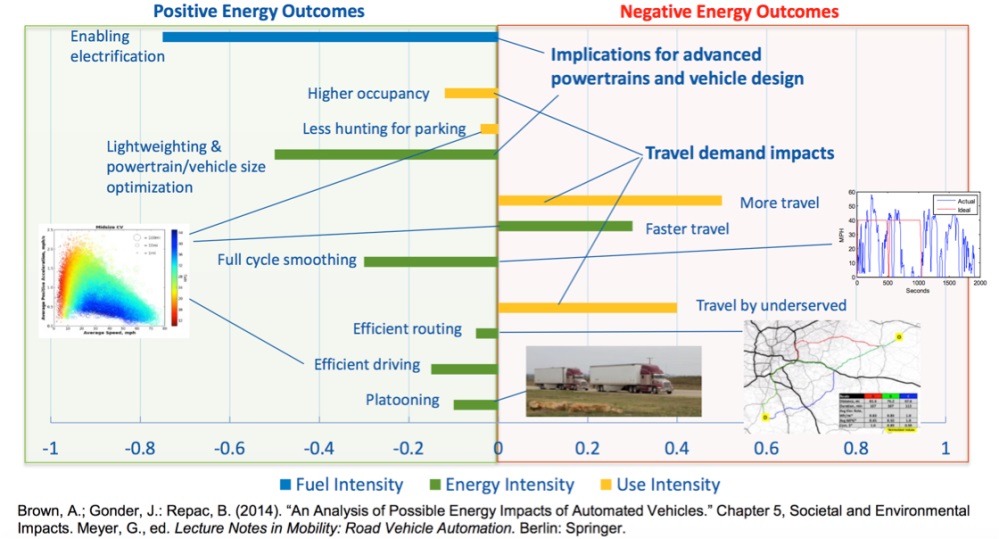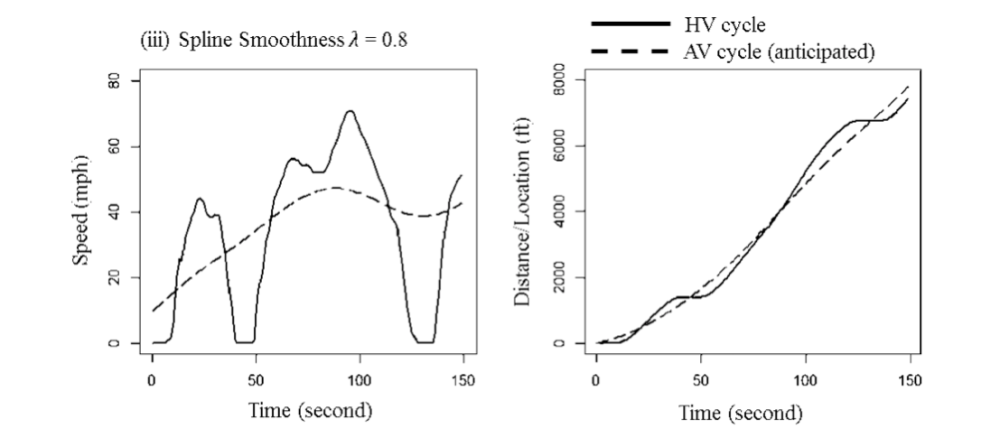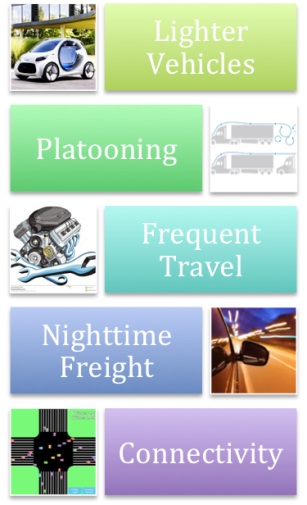Environmental Impacts of Automated Vehicles

In 2015, 27% of greenhouse gas emissions in the US were due to transportation (EPA, 2017). Fully automated vehicles (AVs) are likely to change this contribution to emissions, but how it will change is still uncertain. These will follow other changes in vehicle operations, vehicle design, or transportation system design, which may be facilitated by automation (Wadud et al., 2016). Many aspects of AVs will bring about positive energy impacts, while others will likely cause negative energy impacts. These factors are summarized in the graphic below (Gonder et al., 2016, p. 3). While increases in travel demand would largely increase emissions, AVs have the potential to reduce this effect overall.

Vehicle-Miles Traveled
AVs will likely increase vehicle miles traveled (VMT) as mobility increases and encourages travel. VMT will also increase with the rise of shared (fully) automated vehicles (SAVs) due to extra empty driving between stops and to and from charging stations, in the case of electric vehicles. The table below summarizes the estimates for this VMT increase based on different models and parameters.
| Study | Method | Estimate | Sources of increase or decrease in VMT |
|---|---|---|---|
| Brown et al. (2014) | Additional miles if all people over 16 had VMT of highest demographic | Upper bound annual VMT: +40% | New demand from underserved populations (youth, disabled, and elderly) |
| Childress et al. (2015) | Activity-Based Model | Daily VMT: -35% to 20% | Changes in value of travel time, road capacity, parking costs and per mile driving costs. |
| Fagnant and Kockelman (2014) | Agent-Based Model | Daily VMT: +11% | Relocation of unoccupied automated taxis |
| Fagnant and Kockelman (2015) | Assumptions based on published literature | VMT per AV: +10% to +20% | Induced Demand |
| Schoettle and Sivak (2015) | Developed trip overlap and household requirements in an AV environment | Upper Bound VMT per AV: +75% | Reductions in household vehicle ownership |
| Wadud et al. (2016) | Assumptions based on natural declines in travel due to age | Upper Bound Annual VMT: +10% | New demand from new user groups |
| Harper et al. (2016) | Demand Wedges | Upper Bound Annual VMT: +14% | New demand from underserved populations |
| Liu et al. (2017) | Activity-Based Agent-Based Model | Daily VMT: +9.8% to 15.7% | Empty SAV repositioning |
| Perrine et al. (2018) | Trip-Based Model | Daily VMT: +9.6% | Destination choice due to the change of value of travel time |
In order to minimize this VMT increase, a certain policy can be put in place. The Autonomous Vehicle Policy Framework Summit Report suggests that the best practice for tackling the emissions issue is encouraging zero emission AVs with clean energy sources, to reduce impacts on air quality (Snyder et al., 2017, p. 8). See more policy recommendations on the Automated Vehicle Policy page.
Hybrid and Electric AVs
If the benefits of electrification are realized, they would far outweigh the worst case impacts from increased VMT. However, it may be difficult and costly to fully implement electric automated vehicles (EVs) to the extent that we would see this benefit. Fully electric vehicles would require constant and convenient access to charging stations, which may contribute to congestion and increases in VMT. Alternatively, hybrid automated vehicles (HAVs), prove to provide a significant benefit, and are less costly overall, “the main advantage of EV HAVs will be the environmental benefits they bring, in particular, emissions at the point of use (IMInnovation, 2017).” According to Loeb and Kockelman, EVs, unlike Hybrid EVs (HEV) or AVs, “have the potential to provide zero-carbon transportation with a renewable power grid,” (Loeb and Kockelman, 2017, p. 1). However, at this time, it appears that HEVs would be more easily integrated because they allow for more leeway in the availability of charging stations. The choice between the types of HAVs will “depend on the progress in battery technology over the next few years, and specifically in power density, charging time and effective cycles. These improvements will help to remove concerns about the range they can travel to, without having to pause to re-charge” (IMInnovation, 2017). According to Loeb et al., “as the price of EV batteries continues to fall, charging facilities become more convenient, and renewable energy sources grow in market share, EVs will become more economically and environmentally competitive with conventionally fueled vehicles” (Loeb et al., 2018, p. 1).
Shared (Fully) Automated Vehicles
While SAVs are likely to increase VMT, they may still bring energy and fuel savings if implemented carefully. According to Fagnant and Kockelman, “SAVs may be purpose-built as a fleet of passenger cars, replacing many current, heavier vehicles with higher emissions rates,” (Fagnant et al., 2015, p. 15). Simulation-based estimations suggest that “SAV fleets could deliver an energy savings of 12%, along with a 5.6% reduction in greenhouse gas (GHG) emissions, relative to privately owned and operated human-driven vehicles,” (Kockelman et al., 2016, p. 211). Electrification is relevant to the future of SAVs as well. EVs are an attractive option for SAVs because of energy efficiency and reduced emissions, but a simulation-based study in Austin, TX found that “for all metrics studied, a gasoline hybrid-electric (HEV) fleet performed better than EV fleets, while remaining more profitable, providing response times of 4.5 minutes” (Loeb and Kockelman, 2017, p. 1).
Engine Load Smoothing
Engine Load Smoothing is the term that refers to the removal of fuel-consuming human driving tendencies like speed fluctuations, long reaction times, hard braking, and rapid acceleration. The graphs below illustrate the potential impacts of removing the human element from the vehicle as fat as the driving cycles are concerned (Liu and Kockelman, 2018, p. 7).

As noted in a 2016 study sponsored by the Texas Department of Transportation on connected and autonomous transportation systems, “hard braking and rapid acceleration events are associated with increased emissions, so, by smoothing HVs’ existing driving cycles, this work anticipates the emission benefits of CAVs.” More efficient driving habits, as well as more efficient engines, will lead to decreased emissions per VMT due to more gradual acceleration and deceleration in driving cycles (Kockelman et al., 2016, p. 229). However, safety and human capabilities generally limit highway speeds, while AVs may be capable of driving at higher speeds more safely in the future, which could increase energy consumption per mile (Wadud et al., 2016).
Other Environmental Benefits of AVs
 In addition to the incorporation of hybrid and electric vehicles, SAVs, and cycle smoothing, there are other minor environmental benefits associated with AVs. AVs are anticipated to be lighter in many cases, as passengers are less likely to need to keep their belongings in their vehicles and as SAVs become more widespread. AVs may also become lighter in the long term due to reduced safety equipment, if crash rates are greatly reduced. Truck platooning will also likely decrease emissions through the utilization of vehicle spacing, cruising speed, vehicle loading, and engine loading (Gonder, 2016, p. 7). While more frequent travel through the mobility service of SAVs, it will also decrease the number of cold starts. Cold-start emissions are much higher than after a vehicle’s catalytic converter has warmed up (Loeb et al., 2018, p. 5). There is potential to move freight trips or others to nighttime travel or other off-peak times to reduce congestion and emissions (due to cooler nighttime weather) (Snyder et al., 2017, p. 20). Connectivity of vehicles between their environment and each other through cooperative intersection coordination and coordinated adaptive cruise control will also help to decrease emissions due to more efficient travel and fewer start-stop requirements of the vehicle.
In addition to the incorporation of hybrid and electric vehicles, SAVs, and cycle smoothing, there are other minor environmental benefits associated with AVs. AVs are anticipated to be lighter in many cases, as passengers are less likely to need to keep their belongings in their vehicles and as SAVs become more widespread. AVs may also become lighter in the long term due to reduced safety equipment, if crash rates are greatly reduced. Truck platooning will also likely decrease emissions through the utilization of vehicle spacing, cruising speed, vehicle loading, and engine loading (Gonder, 2016, p. 7). While more frequent travel through the mobility service of SAVs, it will also decrease the number of cold starts. Cold-start emissions are much higher than after a vehicle’s catalytic converter has warmed up (Loeb et al., 2018, p. 5). There is potential to move freight trips or others to nighttime travel or other off-peak times to reduce congestion and emissions (due to cooler nighttime weather) (Snyder et al., 2017, p. 20). Connectivity of vehicles between their environment and each other through cooperative intersection coordination and coordinated adaptive cruise control will also help to decrease emissions due to more efficient travel and fewer start-stop requirements of the vehicle.
